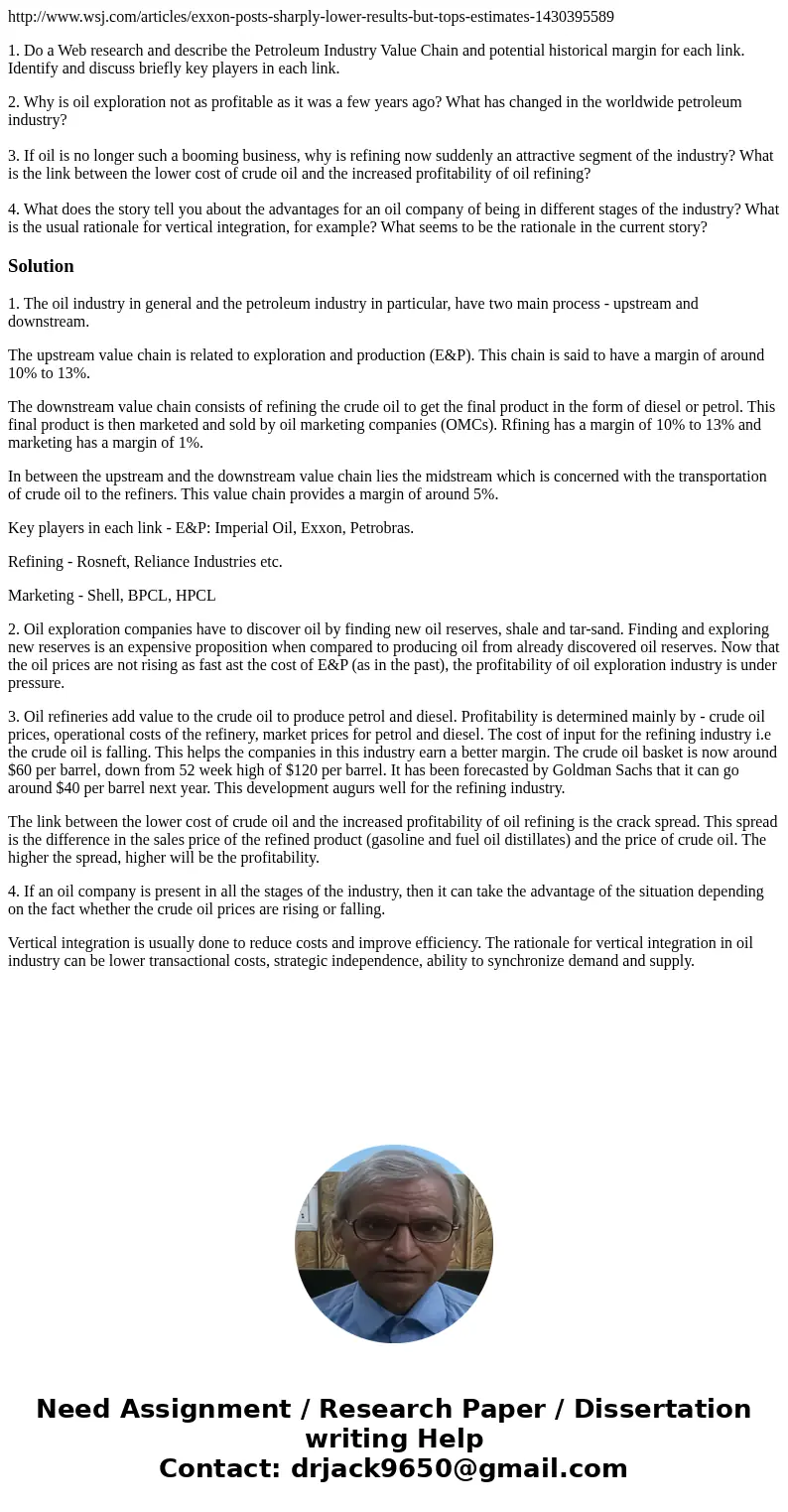httpwwwwsjcomarticlesexxonpostssharplylowerresultsbuttopsest
http://www.wsj.com/articles/exxon-posts-sharply-lower-results-but-tops-estimates-1430395589
1. Do a Web research and describe the Petroleum Industry Value Chain and potential historical margin for each link. Identify and discuss briefly key players in each link.
2. Why is oil exploration not as profitable as it was a few years ago? What has changed in the worldwide petroleum industry?
3. If oil is no longer such a booming business, why is refining now suddenly an attractive segment of the industry? What is the link between the lower cost of crude oil and the increased profitability of oil refining?
4. What does the story tell you about the advantages for an oil company of being in different stages of the industry? What is the usual rationale for vertical integration, for example? What seems to be the rationale in the current story?
Solution
1. The oil industry in general and the petroleum industry in particular, have two main process - upstream and downstream.
The upstream value chain is related to exploration and production (E&P). This chain is said to have a margin of around 10% to 13%.
The downstream value chain consists of refining the crude oil to get the final product in the form of diesel or petrol. This final product is then marketed and sold by oil marketing companies (OMCs). Rfining has a margin of 10% to 13% and marketing has a margin of 1%.
In between the upstream and the downstream value chain lies the midstream which is concerned with the transportation of crude oil to the refiners. This value chain provides a margin of around 5%.
Key players in each link - E&P: Imperial Oil, Exxon, Petrobras.
Refining - Rosneft, Reliance Industries etc.
Marketing - Shell, BPCL, HPCL
2. Oil exploration companies have to discover oil by finding new oil reserves, shale and tar-sand. Finding and exploring new reserves is an expensive proposition when compared to producing oil from already discovered oil reserves. Now that the oil prices are not rising as fast ast the cost of E&P (as in the past), the profitability of oil exploration industry is under pressure.
3. Oil refineries add value to the crude oil to produce petrol and diesel. Profitability is determined mainly by - crude oil prices, operational costs of the refinery, market prices for petrol and diesel. The cost of input for the refining industry i.e the crude oil is falling. This helps the companies in this industry earn a better margin. The crude oil basket is now around $60 per barrel, down from 52 week high of $120 per barrel. It has been forecasted by Goldman Sachs that it can go around $40 per barrel next year. This development augurs well for the refining industry.
The link between the lower cost of crude oil and the increased profitability of oil refining is the crack spread. This spread is the difference in the sales price of the refined product (gasoline and fuel oil distillates) and the price of crude oil. The higher the spread, higher will be the profitability.
4. If an oil company is present in all the stages of the industry, then it can take the advantage of the situation depending on the fact whether the crude oil prices are rising or falling.
Vertical integration is usually done to reduce costs and improve efficiency. The rationale for vertical integration in oil industry can be lower transactional costs, strategic independence, ability to synchronize demand and supply.

 Homework Sourse
Homework Sourse